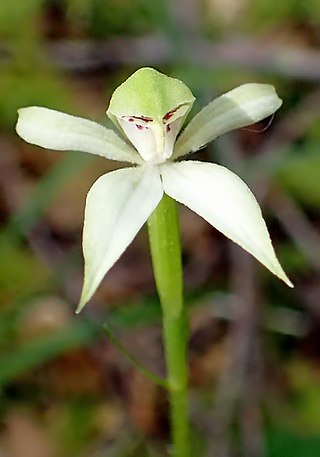
Adenochilus, commonly known as gnome orchids is a genus of two species of flowering plants in the orchid family Orchidaceae, one endemic to New Zealand and the other to Australia. Both species have a long, horizontal, underground rhizome with a single leaf on the flowering stem and a single resupinate flower with its dorsal sepal forming a hood over the labellum and column.

Bossiaea cordigera , commonly known as wiry bossiaea, is a species of flowering plant in the family Fabaceae and is endemic to southern Australia. It is a straggling shrub with wiry branches, egg-shaped to more or less heart-shaped leaves and yellow and red flowers.
Herpolirion is a genus of perennial herbs in the family Asphodelaceae, subfamily Hemerocallidoideae. The sole species is Herpolirion novae-zelandiae, commonly known as sky lily. It is native to New Zealand as well as the states of New South Wales, Victoria and Tasmania in Australia.
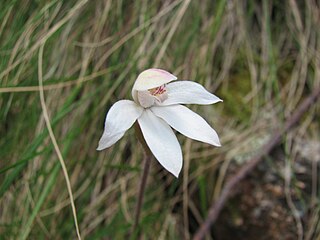
Caladenia alpina, commonly known as the mountain caladenia, is a plant in the orchid family Orchidaceae and is native to subalpine areas of south-eastern Australia and to New Zealand. It has a single fleshy leaf and a thin wiry flowering spike bearing two white flowers with red bars on the labellum. In New Zealand this orchid is sometimes known as Caladenia lyallii.

The Flora Antarctica, or formally and correctly The Botany of the Antarctic Voyage of H.M. Discovery Ships Erebus and Terror in the years 1839–1843, under the Command of Captain Sir James Clark Ross, is a description of the many plants discovered on the Ross expedition, which visited islands off the coast of the Antarctic continent, with a summary of the expedition itself, written by the British botanist Joseph Dalton Hooker and published in parts between 1844 and 1859 by Reeve Brothers in London. Hooker sailed on HMS Erebus as assistant surgeon.
The Flora Novae-Zelandiae is a description of the plants discovered in New Zealand during the Ross expedition written by Joseph Dalton Hooker and published by Reeve Brothers in London between 1853 and 1855. Hooker sailed on HMS Erebus as assistant surgeon. It was the third in a series of four Floras in the Flora Antarctica, the others being the Botany of Lord Auckland's Group and Campbell's Island (1843–45), the Botany of Fuegia, the Falklands, Kerguelen's Land, Etc. (1845–1847), and the Flora Tasmaniae (1853–1859). They were "splendidly" illustrated by Walter Hood Fitch.
The Flora Tasmaniae is a description of the plants discovered in Tasmania during the Ross expedition written by Joseph Dalton Hooker and published by Reeve Brothers in London between 1855 and 1860. Hooker sailed on HMS Erebus as assistant surgeon. Written in two volumes, it was the last in a series of four Floras in the Flora Antarctica, the others being the Botany of Lord Auckland's Group and Campbell's Island (1843–1845), the Botany of Fuegia, the Falklands, Kerguelen's Land, Etc. (1845-47), and the Flora Novae-Zelandiae (1851–1853). They were "splendidly" illustrated by Walter Hood Fitch.
The Botany of Fuegia, the Falklands, Kerguelen's Land, Etc. is a description of the plants discovered in these islands during the Ross expedition written by Joseph Dalton Hooker and published by Reeve Brothers in London between 1845 and 1847. Hooker sailed on HMS Erebus as assistant surgeon. It was the second in a series of four Floras in the Flora Antarctica, the others being the Flora of Lord Auckland and Campbell's Islands (1843-1845), the Flora Novae-Zelandiae (1851–1853), and the Flora Tasmaniae (1853–1859). They were "splendidly" illustrated by Walter Hood Fitch.
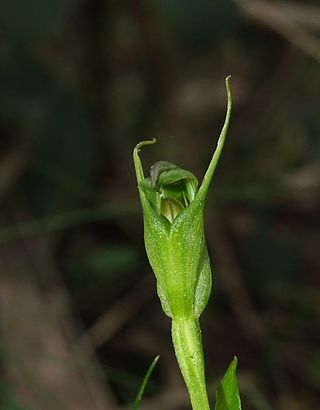
Pterostylis foliata, commonly known as the slender greenhood, is a species of orchid widespread in south-eastern Australia and New Zealand. Flowering plants have a rosette of three to six, dark green, crinkled leaves crowded around the flowering stem and a single dark green and brown flower with a deep V-shaped sinus between the lateral sepals.
Pterostylis puberula, commonly known as the dwarf greenhood or snail greenhood is a species of orchid which is endemic to New Zealand. It has a rosette of pale yellowish, stalked leaves and a single silvery-white and green flower with relatively long, erect lateral sepals.
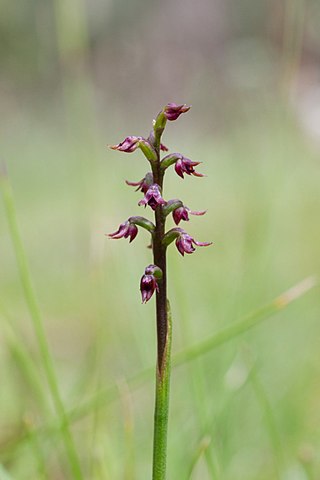
Genoplesium nudum, commonly known as the tiny midge orchid in Australia or the red midge orchid in New Zealand, is a small terrestrial orchid native to south-eastern Australia and New Zealand. It has a single thin leaf fused to the flowering stem and up to forty small, reddish-purple or green and red flowers. Australian and New Zealand authorities use the name Corunastylis nuda but Genoplesium nudum and Prasophyllum transversum are used by the World Checklist of Selected Plant Families.
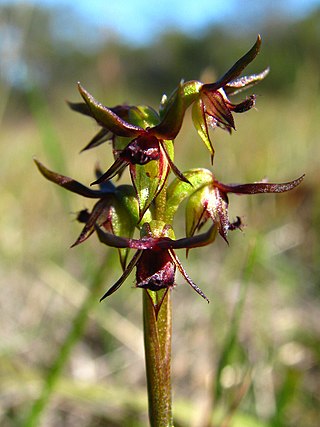
Genoplesium archeri, commonly known as the elfin midge orchid and as Corunastylis archeri in Australia, is a small terrestrial orchid endemic to south-eastern Australia. It has a single thin leaf fused to the flowering stem and up to fifteen small, hairy, yellowish green flowers with purple stripes. It grows in a wide range of habitats in New South Wales, Victoria and Tasmania.

Genoplesium pumilum, commonly known as the green midge orchid in Australia, and the yellow gumland leek orchid in New Zealand is a small terrestrial orchid native to south-eastern Australia and New Zealand. It has a single thin leaf fused to the flowering stem and up to twenty five green to yellowish-green flowers which sometimes have red markings. Australian and New Zealand authorities use the name Corunastylis pumila.
Cyrtostylis oblonga, commonly known as the winter orchid or gnat orchid, is a species of orchid endemic to New Zealand. It has a single rounded leaf and a flowering stem with up to four pink or pinkish green flowers with a flat, oblong labellum.
Cyrtostylis rotundifolia, commonly known as the winter orchid or gnat orchid, is a species of orchid endemic to New Zealand. It has a single egg-shaped leaf and a flowering stem with up to four pink or pinkish green flowers with a flat, oblong labellum. It is very similar to Cyrtostylis oblonga and more investigation is required to determine if they are distinct from each other.

Thelymitra pulchella, commonly called the striped sun orchid, is a species of orchid in the family Orchidaceae that is endemic to New Zealand. It has a single erect, fleshy, channelled leaf and up to fourteen blue flowers with darker stripes on the petal and sometimes also on the sepals. The column and its lobes are variable in shape and colour.
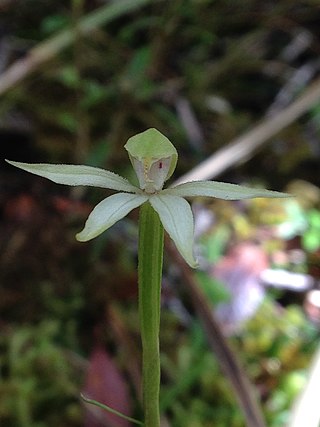
Adenochilus gracilis is a plant in the orchid family Orchidaceae and is endemic to New Zealand. It has a long, thin underground rhizome, a single leaf on the flowering stem and a single white flower with glandular hairs on the outside. Its labellum has red to maroon bars and a central band of yellow calli, but is almost obscured by the dorsal sepal.
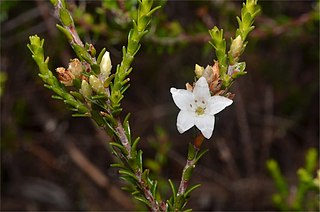
Epacris petrophila, commonly known as snow heath, is a species of flowering plant from the heath family, Ericaceae, and is endemic to south-eastern Australia. It is an erect, bushy, sometimes low-lying shrub with egg-shaped to elliptic leaves and tube-shaped white flowers in small clusters on the ends of branches.
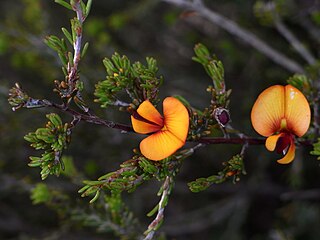
Pultenaea prostrata, commonly known as silky bush-pea, is a species of flowering plant in the family Fabaceae and is endemic to south-eastern Australia. It is a small, rigid, wiry, low-lying or prostrate shrub with cylindrical leaves, and yellow, red and purple-brown flowers.
Puccinellia stricta is a species of grass known by the common names Australian saltmarsh grass, and Marshgrass. It was first described by Joseph Dalton Hooker in 1853 as Glyceria stricta from a specimen collected at Akaroa, but was assigned to the genus, Puccinellia, in 1930 by Carl Hilding Blom. It is native to New Zealand and Australia, where it is found in Western Australia, South Australia, Victoria and Tasmania.












